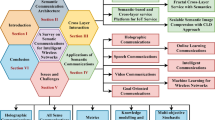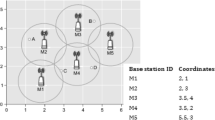Abstract
The increase in the users’ demand has led to massive success of wireless technology during the last two decades. Wireless mesh networks are a booming technology which have developed and grabbed attention significantly. In this paper, the problem of Internet Gateway (IGW) selection is addressed with regard to network traffic and reliability of routes and a Reliability and Traffic aware Gateway Selection scheme is proposed. To the best of our knowledge, no work in the literature has considered the impact of reliability of routes on the selection of gateways in their scenarios. Given the number of mesh nodes in the network, some Internet Gateway Candidates are selected regarding the traffic in the network. Then, the best of these candidates are selected to be equipped with gateway functionality taking into consideration of the path-tracing method. Simulation results demonstrate how our novel mechanism outperforms two successful approaches in IGW selection in terms of throughput, delay and network energy consumption.










Similar content being viewed by others
References
Akyildiz, I. F., Wang, X., & Wang, W. (2005). Wireless mesh networks: A survey. Computer Networks, 47, 445–487.
Ng, P. C., & Liew, S. C. (2007). Throughput analysis of IEEE 802.11 multi-hop ad hoc networks. IEEE/ACM Transactions on Networking, 15(2), 309–322.
Bhatia, R., & Li, L. (2007). Throughput optimization of wireless mesh networks with mimo links. In 26th IEEE International Conference on Computer Communications. INFOCOM (pp. 2326–2330).
Bianchi, G. (2000). Performance analysis of the IEEE 802.11 distributed coordination function. IEEE Journal on Selected Areas in Communications, 18(3), 535–547.
Liu, W., Nishiyama, H., Kato, N., Shimizu, Y., & Kumagai, T. (2013). A novel gateway selection technique for throughput optimization in configurable wireless mesh networks. Wireless Information Networks, 20, 195–203.
Ashraf, O., Abdellatif, S., & Juanole, G. (2009). Gateway selection in backbone wireless mesh networks. In Wireless communications and networking conference (pp. 1–6).
Boushaba, M., Hafid, A., & Gendreau, M. (2014). Source-based routing in wireless mesh networks. Systems Journal, 10, 262–270.
Galvez, J. J., Ruiz, P. M., & Skarmeta, A. F. G. (2011). Responsive on-line gateway load balancing for wireless mesh networks. Ad Hoc Newtorks, 10, 46–61.
Wu, W., Luo, J., & Yang M. (2009). Gateway placement optimization for load balancing in wireless mesh networks. In 13th international conference on computer supported cooperative work in design (pp. 408–413).
Jahanshahi, M., Dehghan, M., & Meybodi, M. R. (2013). LAMR: Learning automata based multicast routing protocol in multi-channel multi-radio wireless mesh networks. Applied Intelligence, 38, 58–77.
Lakshmanan, S., Sivakumar, R., & Sundaresan, K. (2009). Multi-gateway association in wireless mesh networks. Ad Hoc Networks, 7, 622–637.
Gerstel, O., & Ramaswami, R. (2000). Optical layer survivability—An implementation perspective. IEEE Journal on Selected Areas in Communications, 18, 1885–1899.
Aoun, B., Boutaba, R., Iraqi, Y., & Kenward, G. (2006). Gateway placement optimization in wireless mesh networks with QoS Constraints. IEEE Journal on Selected Areas in Communications, 24, 2127–2136.
Yu, W., Fan, L., Li, X.-Y., Nusairat, A., & Wu, Y. (2008). Gateway placement for throughput optimization in wireless mesh networks. Mobile Networks and Applications, 13, 198–211.
Chandra, R., Qiu, L., Jain, K., & Mahdian, M. (2004). Optimizing the placement of integration points in multi-hop wireless networks. In Proceedings of IEEE ICNP.
Xin, Q., & Wang, Y. J. (2009). Gateway selection scheme for throughput optimization in multi-radio multi-channel wireless mesh networks. In 5th international conference on mobile ad hoc and sensor networks (pp. 187–195).
He, B., Xie, B., & Agrawal, D. P. (2008). Optimizing deployment of internet gateway in wireless mesh networks. Computer Communications, 31, 1259–1275.
Seyedazadegan, M., Othman, M., Ali, B. M., & Subramaniam, S. (2013). Zero-degree algorithm for internet gateway placement in backbone wireless mesh networks. Network and Computer Applications, 36, 1705–1723.
Tokito, H., Sasabe, M., Hasegawa, G., & Nakano, H. (2009). Routing method for gateway load balancing in wireless mesh networks. In ICN’09: Proceedings of the 2009 eighth international conference on networks (pp. 127–132).
Huang, C.-F., Lee, H.-W., & Tseng, Y.-C. (2004). A two-tier heterogeneous mobile ad hoc network architecture and its load-balance routing problem. Mobile Networks and Applications, 9, 379–391.
Xie, B., Yu, Y., Kumar, A., & Agrawal, D. P. (2006). Load–balancing and inter domain mobility for wireless mesh networks. In Global telecommunications conference (pp. 409–414).
Jahanshahi, M., & Barmi, A. T. (2014). Multicast routing protocols in wireless mesh networks: A survey. Computing, 96, 1029–1057.
Galvez, J. J., Ruiz, P. M., & Skarmeta, F. F. A. (2012). Responsive on-line gateway load balancing for wireless mesh networks. Ad Hoc Networks, 10, 46–61.
Nakamura, R., Ono, H., & Nishikawara, K. (1994). Reliable switching services. Globecom, 3, 1596–1600.
Author information
Authors and Affiliations
Corresponding author
Appendix
Appendix
The reliability of IGCs using path tracing method are as below:
For instance P(X3) = P (IGC5-7-10-IGC8) = P (R4) = (0.9)4
Rights and permissions
About this article
Cite this article
Bozorgchenani, A., Jahanshahi, M. A Novel Reliability and Traffic Aware Gateway Selection Scheme in Wireless Mesh Networks. Wireless Pers Commun 96, 6111–6128 (2017). https://doi.org/10.1007/s11277-017-4466-y
Published:
Issue Date:
DOI: https://doi.org/10.1007/s11277-017-4466-y




